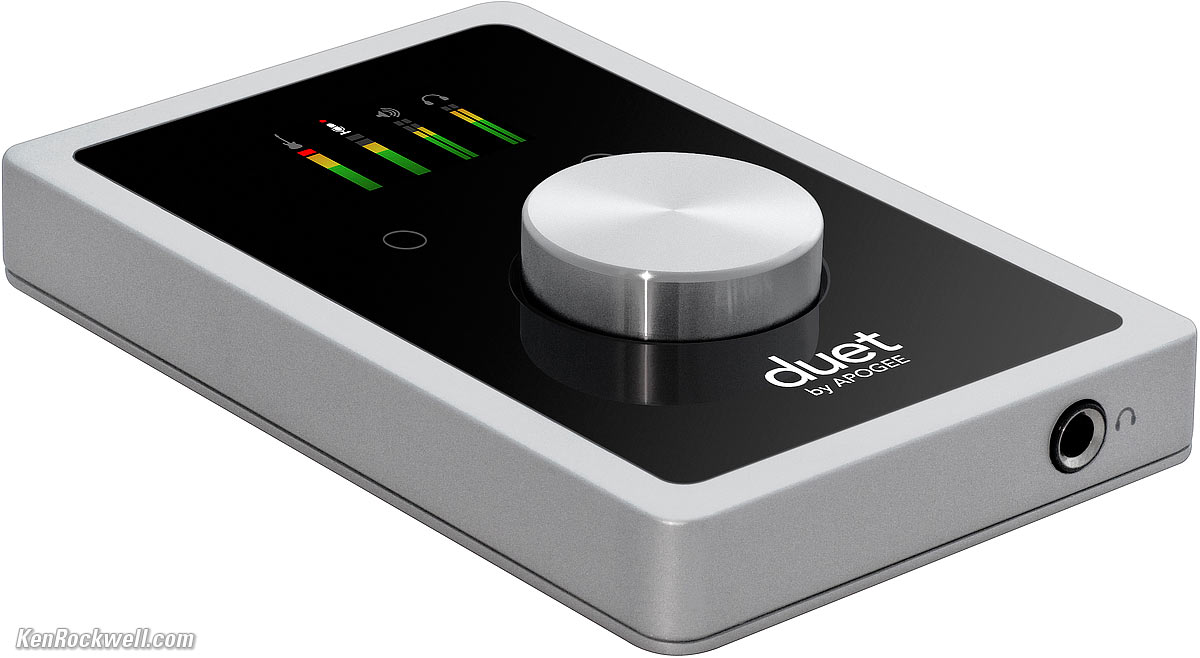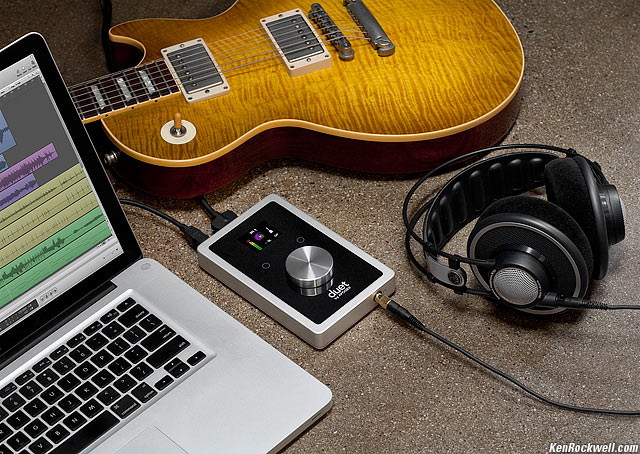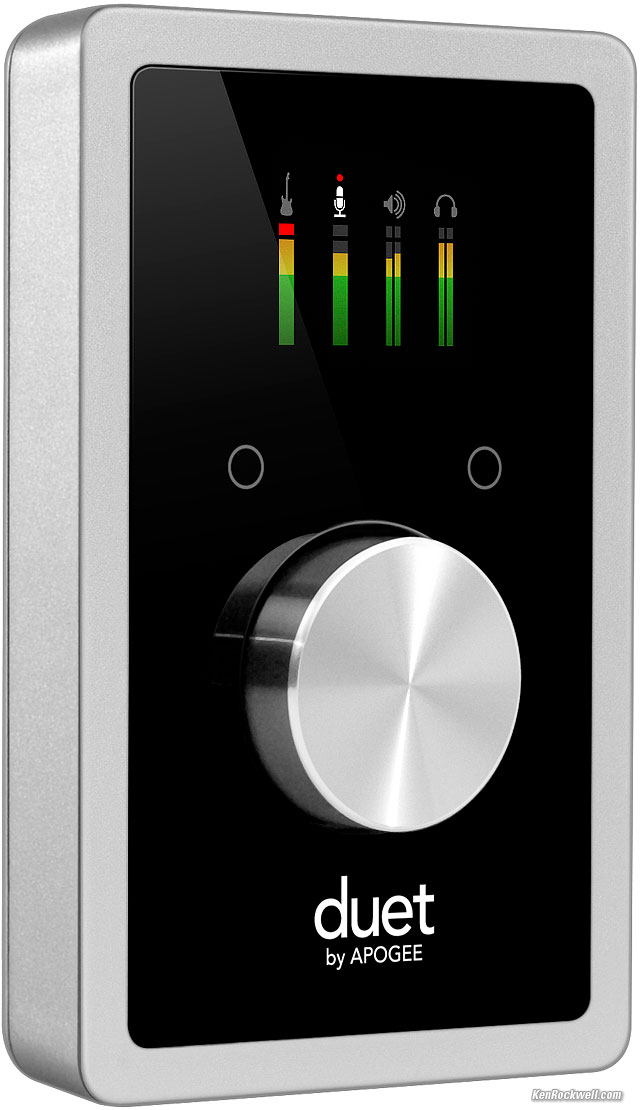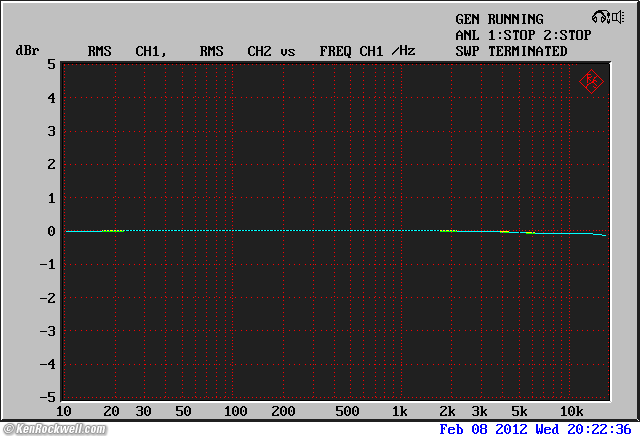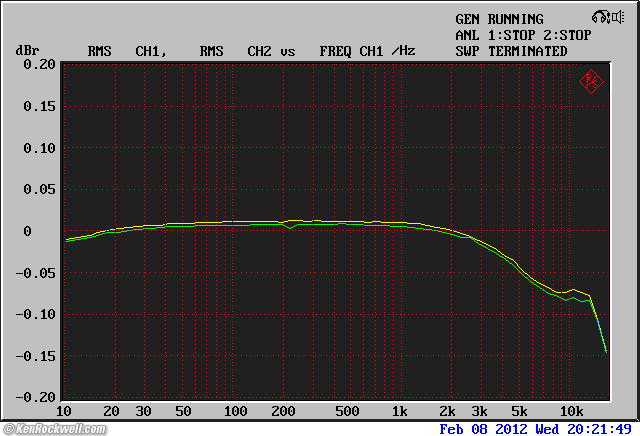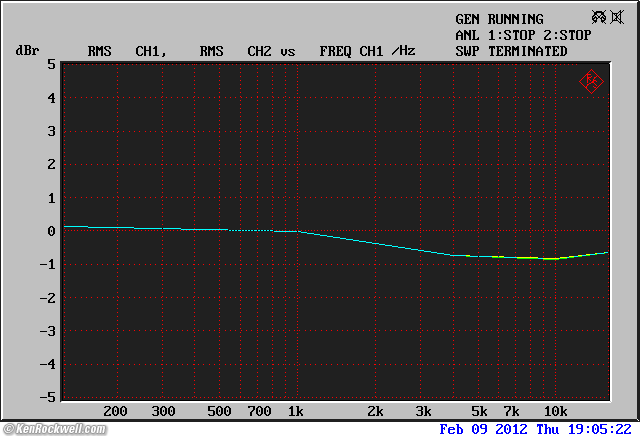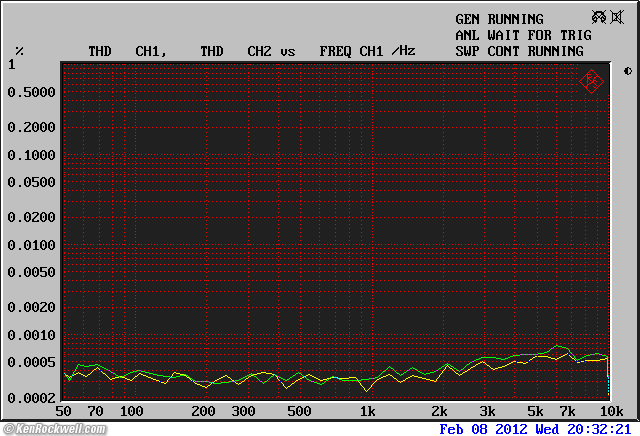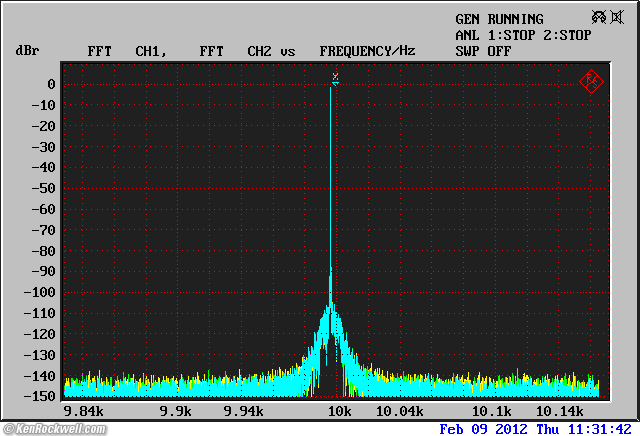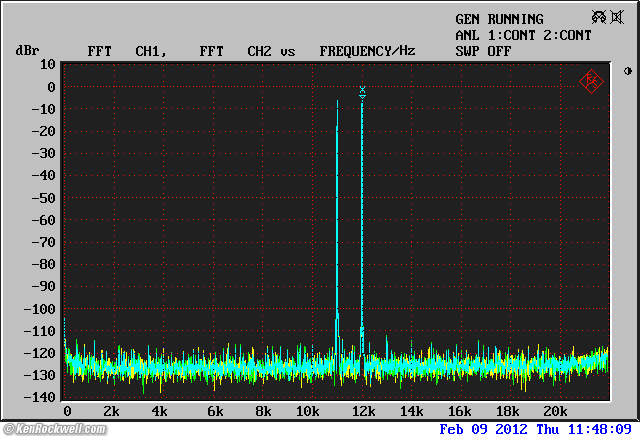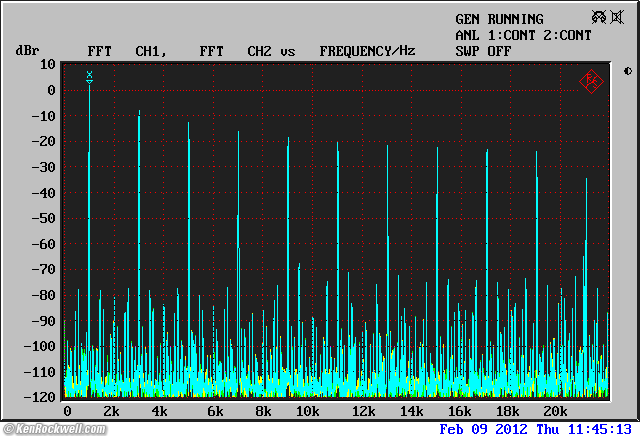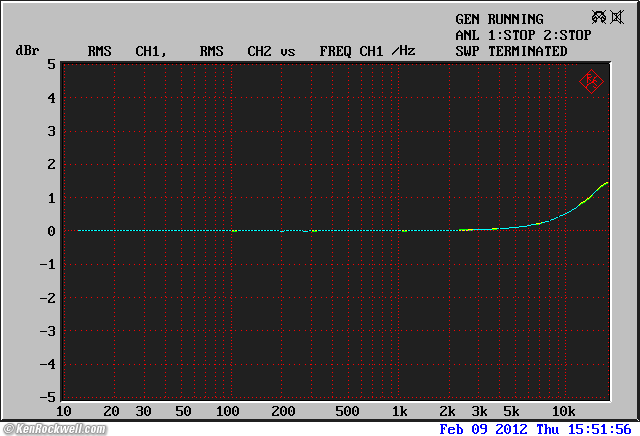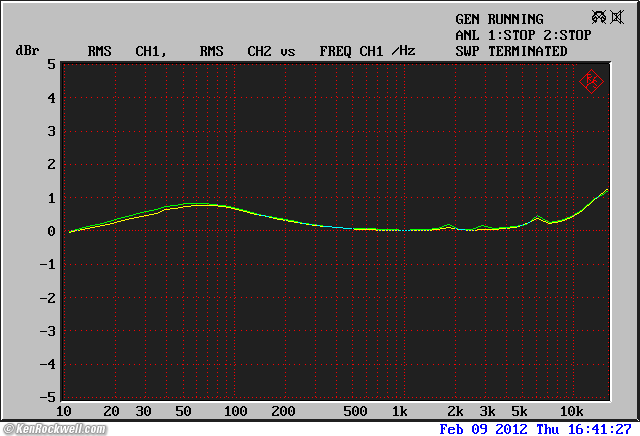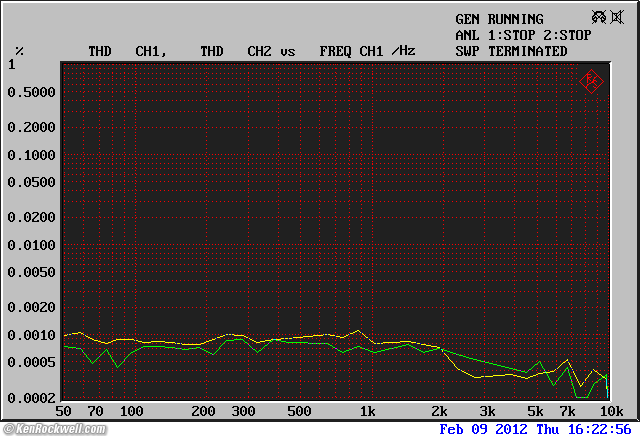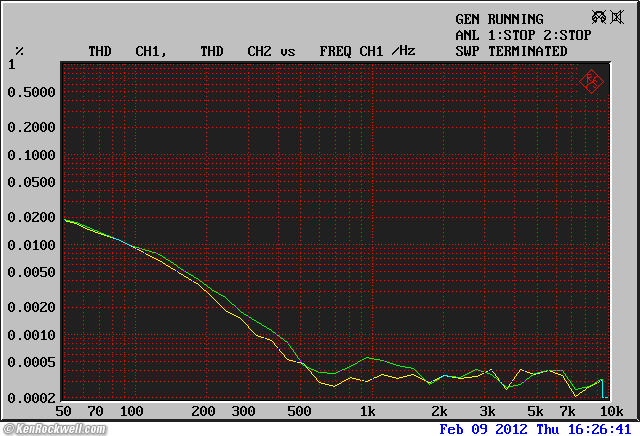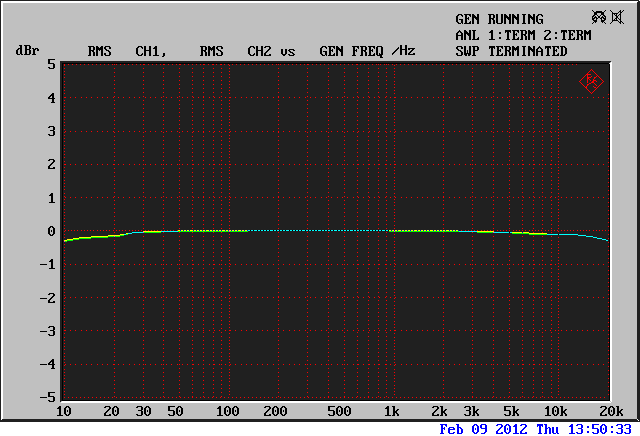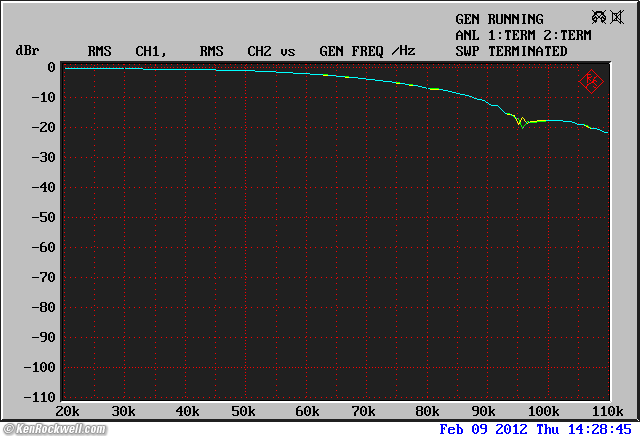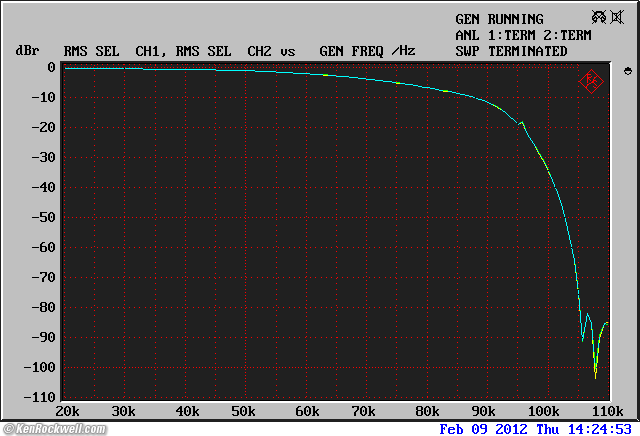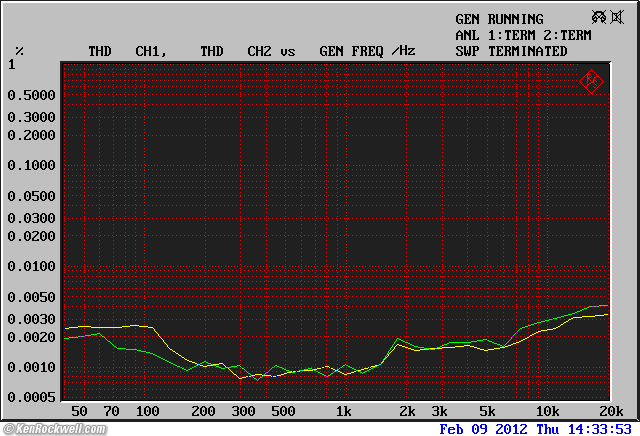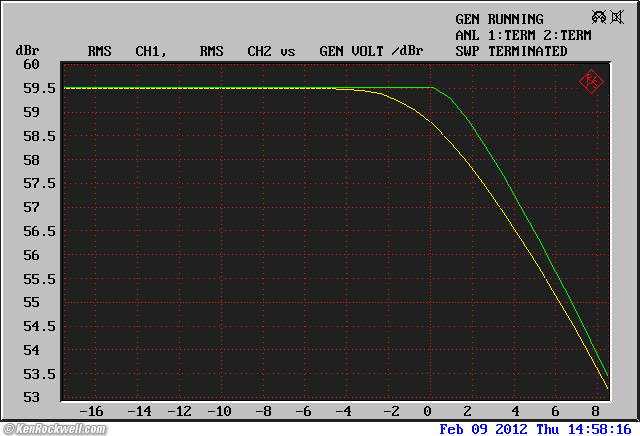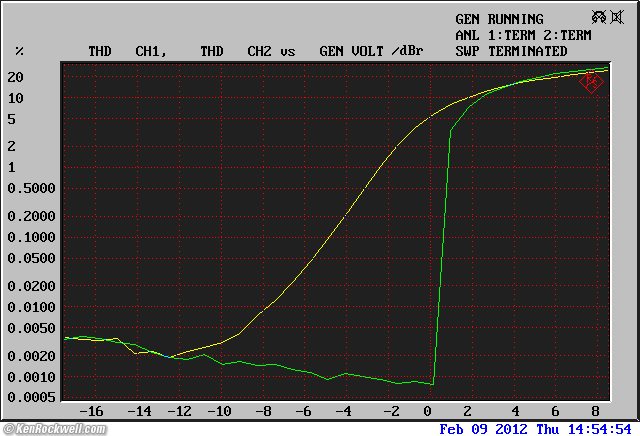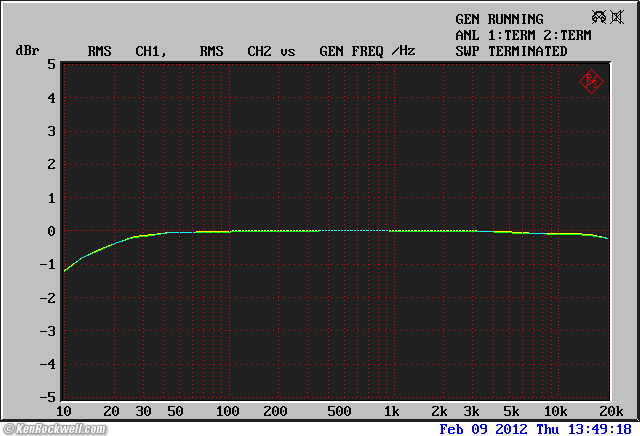Apogee Duet 2
Desktop 192k/24b DAC and ADC (2011-)
MADE IN USA
Intro Specs Performance Measurements Usage Recommendations More
Apogee Duet 2. larger. (17.9 oz/509g, $649). This free website's biggest source of support is when you use these links, especially this link to them at Amazon or at B&H, when you get anything, regardless of the country in which you live. Thanks! Ken.
Top (back), Apogee Duet 2.
April 2012 All Reviews > Audio Reviews > Apogee Reviews
Inputs: USB (also 2 channels of XLR or ¼" mic, line or instrument for recording). Plays any audio that comes out of your Mac: iTunes, YouTube, Pure Music, Internet radio, Logic Pro, ProTools & etc.
Outputs: ¼" headphone, 2 channels of +4 dBu or -10 dBu to go to self-powered monitors or amplifiers.
Power: USB (also AC adapter if needed).
Notable: Small and USB powered, so it fits in my Beyer headphone case. Four channels of DAC; headphone and line outputs can all be different and each has its own separate level control. Built-in color level meters. Superb audio performance and fantastic ergonomics; in a class by itself.
Missing: No TOSLINK, Coax or AES digital inputs or outputs. For professional computers only (MacBook, MacBook Pro, Mac Pro, Mac Mini, iMac, etc.; no windows).
Introduction top
Intro Specs Performance Measurements Usage Recommendations More
|
I buy only from these approved sources. I can't vouch for ads below. |
The Apogee Duet 2 is the world's best-sounding and most convenient computer DAC for desktop audio. It's also a professional monitor controller and headphone amplifier, and all sits on your desk with one big, beautiful knob for easy fingertip control.
I'm showing the old Duet 2 here; the current model adds an iOS interface so you also can use it direct with your iPad and iPhones, as well as USB.
As a professional instrument, it is intended only for use with professional (Apple) computers. It does not work with windows. Among the reasons it works so well is that its firmware gets inside and works seamlessly with the Core Audio of Apple's operating system.
On first listen, the Duet 2 immediately impressed with smooth, detailed powerful, dynamic and elegant natural sound. As a professional studio product, we're getting live in-studio sound with impact and solid, tight and potent deep bass. It adds no audible noise of its own over a huge volume control range, so music comes strongly out of inky black silence at any level setting.
It has four channels of digital-to-analog converter (DAC) so that the speaker (monitor) outputs and headphone outputs can be playing completely different things at different levels — or running main and subwoofer outputs from software like Pure Music.
The volume control is fantastic. The big knob is easy to see and turn with a fingertip as it sits on your desk. Missing on most preamplifiers and DACs is that this level control works over such a wide range that it's easy to set a precise level anywhere from a soft background whisper to completely deafening — all with no audible amplifier noise. Everything else I've tried on my desktop has not enough range to go from playing foreground to background music without needing me also to go into the playback software and add or subtract level there, too. With the Duet 2, all I have to do is spin the big knob right by my left hand on my desk.
Not only does it cover a huge range, the firmware is so smart and seamless that it flicks quickly from loud to soft just like any other real volume control knob, but the clairvoyant firmware allows precise 1 dB adjustment anywhere in the huge level control range. I can't overemphasize how great it is to have my monitors run at any level I want from background music to main event with one big knob, instead of having to lower the sliders in any particular application because the Mac's own speaker level controls are so limited.
The Mac only controls over a 48 dB range broken into only 16 steps, which is fine for 2" speakers that can't get loud even at maximum, but when you're controlling big monitors, you need to go a lot louder, as well as softer, and the Apogee Duet 2 does it all, in precise 1 dB steps. I can set any exact level I want, even at the softest levels.
There are two programmable function buttons above the big knob. I set one to MONO and the other to MUTE SPEAKERS. Another popular setting is to use one button to select which channels are fed to the headphones, for instance, for cueing.
Did I mention it sounds fantastic? Plugging my 600 Ω Beyer DT 880s into it sounded incredible, much better than some of the audiophile attempts that have been here lately. Apogee has been a leader in professional digital audio for as long as there has been professional digital audio. In 1985, Apogee made special anti-alias filters used to improve the performance of professional studio ADCs, and in the 1990s innovated with their own special studio-mastering ADCs and digital processors that cleverly squeezed 20-bit performance into 16-bit CDs. Remember Telarc and other 20-bit CDs? Apogee made those converters, and the same noise-shaping dither technology is still used today in mastering software. In 2012, Apogee converters are used in most of the professional recordings we buy, for instance, here's some of the 2012 Grammy nominees who use Apogee.
A good deal of your favorite CDs and LPs were probably recorded through Apogee converters, so you've been hearing Apogee for a long time.
Nobody knows how to make a great-sounding converter better than Apogee, and the hits prove it. Decades ago their equipment was very expensive, but today, this same technology is what's inside this little Apogee Duet 2. We all can buy professional studio-level equipment for less than most of the audiophile drivel out there that costs so much more and sounds so much worse.
A MacBook, a Les Paul, AKG headphones and an Apogee Duet 2.
The more I listen the better it sounds, but what hits you the moment you plug in your headphones is again how you can crank up the gain to live concert or studio playback levels and it sounds great, and how you can lower the levels to any other level with absolute precision and control — easily and immediately.
As a professional recording product, remember that the Duet 2 is mostly sold to musicians who are going to record through it into their Mac (there are also two professional phantom-powered mic preamps and two 24bit/192k ADCs), and when they play it back, it had better sound as good — and as loud — as it just sounded live. The headphone output of the Duet 2 brings you back into the studio, even played-back from good transfers in iTunes. The headphone amp has no noise, and plays at any level up to and including deafening, even with 600 Ω headphones like the Beyer DT 880. There is always enough gain to hear details in even the quietest sections of classical recordings — and it's doing this powered only via USB.
With sensitive headphones like Ultrasone Edition 8, the Duet 2 will play to beyond deafening (hey, it's a professional studio product).
The headphone and the line (speaker) outputs both have enough gain to let you play the softest sections of classical recordings loudly enough to hear what's going on. If you want to hear the room noise in a classical recording, you're going to hear it.
There are also four channels of color level meters, which are very handy if you are an engineer to know what levels are playing out of your Mac.
For recording, the Mic preamps offer any amount of gain you'd like from 75 dB down to no gain at all (line level), with phantom power. You can mix and pan each line, mic or instrument input separately, or gang them together for stereo, all in the included Maestro 2 software.
At 1 pound (500g) with a rubber bottom, it sits solidly on your desk, and it's small enough to pack in your bag to go anywhere. It's self-powered from USB, and even though the manual cautions that if you're playing low-impedance headphones way too loud that it might actually come up with a request to use the external power adapter, it never had a problem even when I stress-tested it in the lab at maximum sinewave output into 37.5 Ω.
It's all about the big knob and the great sound. I can't find any legitimate way to criticize the Duet 2. Apogee really did their homework listening to what people wanted from the original Apogee Duet, and the seamless way the Duet 2 works really impresses the Dickens out of me. You have to use one to appreciate it, although Amazon's and B&H's user reviews also bear out that everyone loves this thing; and these people are musicians and recording engineers who know how music is supposed to sound.
The fact that the Duet 2 sells for only $649 makes it a no-brainer for anyone needing to get audio out of or into their computer. It's all about performance from one of the world's leaders in music recording, without having to pay for any performance-robbing and price-raising fluff included in exotic (but still garage-shop) audiophile products. Thank goodness there are no annoying blue LEDs on the Apogee, just a nice color OLED panel. Apogee has been making the ADCs and DACs used in the world's top recording and mastering studios for decades. If I can get this quality on my desktop for $595 along with its fantastic ergonomics to control my desktop monitors and drive my headphones, how could I say no?
Apogee Duet 2.
Specifications top
Intro Specs Performance Measurements Usage Recommendations More
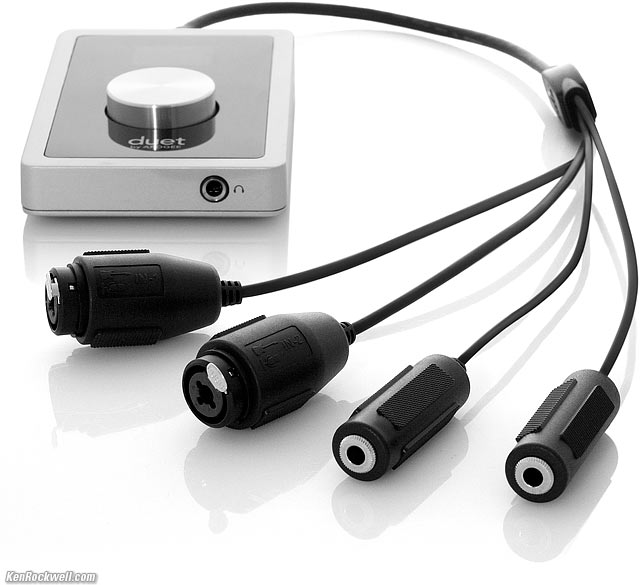
Apogee Duet 2 with included cable. (A break-out box with 6' cord is an option.)
Inputs
Two combo ¼"/XLR on included cable. Amphenol brand audio connectors and Hirose edge connector.
Settable to Instrument (¼") or Mic (XLR).
In Mic or Instrument, the software that runs on your Mac allows selecting +48V phantom, or reversing polarity.
Also settable to +4 dBu or -10 dBu line, in which case, levels are fixed.
If you want variable line levels, use the Mic or Instrument settings. The huge gain ranges cover line levels as well.
The input gain never drops to off or mute, only to very low. If you want to fade to silence, you do that elsewhere.
Outputs
¼" headphone jack on front.
Two ¼" jacks for balanced or unbalanced output. Amphenol brand audio connectors and Hirose edge connector.
Power
USB.
AC adapter included, but was not needed.
Size, including projections
4 × 6-5/16 inches; 1-3/8 inches tall including knob.
(102 × 160 × 35 millimeters.)
Weight
17.950 oz./508.8g, without cord.
Quality
MADE IN THE UNITED STATES OF AMERICA.
Included
Duet 2.
Breakout Cable.
AC Adapter with integral interchangeable plugs for US, UK and EU. It has a short 4' (1.2 m) cord, and is a slim design so it fits most outlet strips without covering any other sockets.
Quick Start Guide.
Software download and installation instructions (No CD; Apogee wants you to get the latest software direct from them.)
Price
$649, April 2020.
Apogee Duet 2 was $595 in April 2012.
Performance top
Intro Specs Performance Measurements Usage Recommendations More
The Duet 2 just works. Everything runs at 192k; even iTunes playback from CDs. There are never any hiccups; it just sounds great — and it's easy.
I run my Duet 2 on a 10-year-old, 6-foot long USB cable plugged into a Belkin 7-way powered USB hub plugged into my hexcore 3.33 GHz MacPro by its own cord, and that's how I tested it. There's no need for finicky USB cords. I also ran it from a 6' USB cord plugged into my MacBook Pro and it worked great. The measurements were made powered from the USB hub from my MacPro.
It has no fans and makes no noise.
Software and Installation
It's trivial to download and install the Maestro 2 software, and once you do, it runs itself. It's only a 7.4 MB program.
Ergonomics
The Duet 2 is the smallest desktop preamp I've used, and it needs no power cord!
It's a solid bar of precision, and the volume control is a dream to spin.
There is no need to look at Duet 2 when setting levels. A display comes up on your Mac as you tap the knob to select what level you are going to control. Meters also come up in Maestro.
The software is brilliant, making the interface between your Mac and the Duet seamless. The level control on your Mac and your Duet talk to each other; use either one and it controls the other. The only gotcha is that the Mac's control won't address the entire level range that the Duet 2 can provide, so you'll probably never bother with those dopey F10, F11 and F12 buttons on your keyboard again once you have the Duet 2 on your desk.
The software makes it easy to assign the Mac's level controls to control the headphone levels instead of the speakers' output levels.
The R and L input and output connector markings are invisible; they should have used Braille or some other way to let us identify them by feel.
Musicians work at night, and recording engineers work in concert halls or studios. The OLED display is optimum for this and is equally bright from any angle. It won't be as visible in daylight; that's not the careful listening environment in which the Duet 2 is designed to flourish.
Measurements top
Intro Specs Performance Measurements Usage Recommendations More
Output Impedance Noise Gain Accuracy Channel Tracking
Frequency Response THD Output Spectra Low-Level Linearity
Headphone Output Analog Inputs
These measurements were made plugging the Duet 2 into a six-year-old Belkin 7-way powered USB hub with a 10-year-old 6-foot USB cord. This hub is connected to my 2010 hexcore 3.33 GHz MacPro by its own cord, and that's how I tested it. I'm not going to waste my time trying to find fancy or short USB cables; this is whatever was at the top of my junk box, so it ought to show how well the Duet 2 works in the real world.
These measurements were made with a $50,000 Rohde & Schwarz UPL laboratory analyzer, mostly playing the CBS CD-1 test CD from iTunes 10.5.3 as encoded as ALC files from my copy of the CD. I did this so that these measurements best represent how well the Duet 2 will work in the real world playing CD-based music from iTunes. Used with fancier software like Logic or Pro Tools at 24-bits or higher sample rates from your own masters may get even better performance.
The traces from the Rohde & Schwarz UPL laboratory analyzer are color coded for the Left Channel and for the Right Channel. When they don't lie on top of each other, it's due to channel imbalance.
Even measured from 44.1/16-bit sources, this DAC is much cleaner than an excellent power amp. Most people have no idea how good is 44.1/16; even at 44.1/16, this will be the cleanest part of your reproduction chain.
Output Levels measurements top
This is with USB power. I didn't test, but it ought to have a little more output run off its AC adapter. No problem, you don't want 7 V RMS unbalanced anyway, the most you want is 2 V RMS for use with consumer equipment before you run the risk of overdriving the next piece of gear.
Balanced Output
Actual output source impedance at 1 kHz: 180 Ω.
7.275V RMS (17.24 dBV, 19.45 dBu) driving 200 kΩ load, full gain at 0 dBFS at 0.00015% THD. If this is 0 dBFS, then +4 dBu for 0 VU will be at -15.45 dBFS.
5.592V RMS (14.95 dBV or 17.17 dBu) driving 600 Ω load, full gain at 0.0002% THD at 0dBFS. If this is 0 dBFS, then +4 dBu for 0 VU will be at -13.17 dBFS.
Unbalanced Output Levels
Actual output source impedance at 1 kHz: 180 Ω.
MOL using only the high side or with shorting adapters: 6.45V RMS at 0.16% THD; use -1dB speaker level at 0 dBFS or it clips. THD 0.0004% at 5.75V out.
4.965V RMS at 0.0009% THD at -1dBFS at 0dB speaker level loaded by 600Ω. Oddly, at the verge of 0.1% THD, adding a 600Ω load both lowers the output voltage and the distortion.
With a 200 kΩ load, set -11 dB for SPEAKER OUT for standard 2 V RMS at full scale (should give 2.05V at 0 dBFS at -11 dB).
Output Source Impedances measurements top
Balanced output
Source impedance at 1 kHz: 180 Ω.
Unbalanced output
Source impedance at 1 kHz: 180 Ω.
Headphone output
Source impedance at 1kHz: 34.3 Ω.
Noise measurements top
The outputs are super-quiet. You can sit a foot away from desktop monitors and not hear any noise, but you'll have tons of gain left over to scare the Dickens out of you if you turn it too high!
Playing digital zeros (CBS CD-1 track 4):
Balanced Output Noise
Speaker Level |
A-weighted |
unweighted |
0 dBFS is |
SNR, A-weighted |
ENOB,* A-weighted |
0 dB |
-104 dBV |
-101 dBV |
+17.24 dBV |
121.2 dB |
19.9 bits |
-20 dB |
-104.5 dBV |
-101.5 dBV |
-2.76 dBV |
101.7 dB |
16.6 bits |
-40 dB |
-103 dBV |
-102.5 dBV |
-22.76 dBV |
80.2 dB |
13.0 bits |
-60 dB |
-102 dBV |
-102 dBV |
-42.76 dBV |
59.2 dB |
9.6 bits |
mute ("-64 dB") |
-102.5 dBV |
-102 dBV |
- ∞ dBV |
- |
- |
* ENOB (effective number of bits) = (SNR - 1.72 dB) / 6.0206.
DC Offset: 392 µV left, -196 µV right.
Unbalanced Output Noise
The noise measured a few dB higher; -96 dBV left and -100 dBV right, regardless of gain setting. I suspect this is more from noise picked up in the unbalanced cables and ground loops between digital computers and analog circuits than anything in the Duet 2.
DC Offset: -415 µV left, 820 µV right. This could be why I get thumps when I sleep my Mac with my monitor chain still on.
Gain Accuracy measurements top
Speaker Level Setting |
Relative Output Level |
0 dB |
0.0000 dB |
-1 dB |
-1.0002 dB |
-3 dB |
-2.9942 dB |
-6 dB |
-5.994 dB |
-10 dB |
-9.983 dB |
-20 dB |
-19.981 dB |
-30 dB |
-29.98 dB |
-40 dB |
-39.99 dB |
-50 dB |
-49.98 dB |
-60 dB |
-59.99 dB |
-63 dB |
-62.99 dB |
mute ("-64 dB") |
-153 dB (noise) |
I didn't test the headphone gain to this detail, however it seems as accurate, too.
THis is better than anything short of an analyzer with a five-figure price tag, bravo!
Channel Tracking measurements top
The channel tracking is extremely tight; the stereo image will not wander at all as the levels are changed.
Right channel level versus left channel, vs. Speaker level setting. (positive means image moves to right. R&S UPL.)
Same thing, extremely expanded scale. (positive means image moves to right. R&S UPL.)
Frequency Response measurements top
Frequency response, balanced line output, undithered sine wave at 0 dBFS, Speaker level set to 0 dB. (CBS CD-1 track 11, R&S UPL.)
I also measured response with the Speaker level set to - 20 dB and -40 dB, and it was unchanged. I didn't bother to show those here.
Frequency response, balanced line output, undithered sine wave at 0 dBFS, Speaker level at 0 dB (same with Speaker level set to -20 and -40 dB). (CBS CD-1 track 11, R&S UPL.)
The capacitance of my balanced cables was 127 pF, which with the 180Ω source impedance, could be causing this.
This plot goes to 18 kHz. Oddly, 20 kHz response was down 8.623 dB as played back through iTunes and -78.6 dB at 22 kHz.
I got curious and played the same track in Pure Music from iTunes, and the 20 kHz response was down only 0.20 dB at 20 kHz and down only 3.993 dB at 22 kHz, all from a 44.1 ksps (kilosamples per second) file. I don't care, since the only thing up there is noise, but you might. I didn't measure the digital output of my Mac directly from these programs, which would be enlightening. Oddly, the Duet 2 runs at 192 ksps played from iTunes with 44.1 ksps files, but played from Pure Music, the Duet 2 only runs at 44.1 ksps with 44.1 ksps files.
Deemphasis error, undithered sine wave at -20 dBFS. (CBS CD-1 track 12, R&S UPL.)
Aha! It's down almost 1 dB playing files from CDs with preemphasis! I don't know if this is iTunes or the DAC; in any case, the 1 dB drop in the upper midrange may be an Apogee trick to make these early (1980s) CDs sound even smoother. Apogee knows more about how to make digital sound great than anyone.
THD: 0.00018% (-111 dB) measurements top
Harmonic components, line output, 1kHz at -1 dBFS, 96k/24-bit file. (R&S UPL.)
THD, line output at 7V RMS, undithered sine wave at 0 dBFS, 22kHz bandwidth. (CBS CD-1 track 11, R&S UPL.)
This is much cleaner than any power amplifier I've ever tested. Distortion isn't an issue here; the Duet 2 tests as well as if it's a piece of laboratory equipment.
Output Spectra measurements top
Apogee Duet 2 line output at 10 kHz at -1 dBFS, 44.1k/24-bit file.
Compare this to my other DAC and CD player tests to see the relative effects of real-world jitter. The narrower and more attenuated the skirts, the better. The Sony SCD-XA777ES is cleaner, but that's the advantage of a one-box player with its own DAC that drives the platter as part of a servo loop, and not a DAC like this trying to recover whatever word clock is embedded in the USB signal.
Apogee Duet 2 line output at 11 kHz and 12 kHz 1:1. (CBS CD-1 track 13, index 2, R&S UPL.)
Compare this to my other DAC and CD player tests to see the relative effects of intermodulation distortion and other noise. This Apogee is a bit cleaner than the Sony SCD-XA777ES. Note that the Sony chart is at a different vertical scale; the important part is that the largest spur from the Apogee is about -112 dBFS, while it's about -110 from the state-of-the-art Sony XA777ES.
Apogee Duet 2 line output spectrum, 1 kHz square-wave. (CBS CD-1 track 16, R&S UPL.)
The output from the Sony SCD-XA777ES is much cleaner, without all the spurs starting at -70 dB. From a 1 kHz square wave, there should be strong harmonics at every odd kHz (3 kHz, 5 kHz, 7 kHz, 9 kHz etc.) and nothing else.
Low-Level Linearity measurements top
A -60 dB to -120 dB glide of a dithered 500 Hz sinewave into noise sounds fine, with no distortion. With the Ultrasone Edition 8 plugged in the front, I could hear a clean 500 Hz tone out to 0:24, or -108 dBFS, in a 16-bit track (CBS CD-1 track 20).
Apogee tells me that the analog levels are all controlled in the analog circuitry, with the DACs always run at full level, however listening to this and other very low-level sine-wave tracks, increased distortion is quite audible when the headphone gain is set around the -30 to -40 dB range with very low-level test tones (especially on CBS CD-1 Track 19, dithered 1 kHz at -70 dB FS), suggesting that Apogee might be getting some of the gain range by truncating the digital signal to the DAC. I don't know; 63 dB attenuators aren't that difficult to implement, and I do know that I tested the frequency response also at -20 and -40 dB attenuation, and it was exactly as it was at 0 dB attenuation, which is critical for professional monitoring.
I don't know, but I do know that the Apogee Duet 2 sounds great with music, and with high-level and with low-level test tones at the levels you'd listen to them, and that test signals are for dweebs. The fact that I can break it with very low-level tones set to a narrow range of lower output levels simply serves me right: so what if the Duet 2 isn't very good at doing something no one buys it to do?
There is no distortion audible with normal test signals or music at attenuated settings; it sounds great!
Headphone Output measurements top
Headphone Output Source Impedance
Source impedance at 1kHz: 34.3 Ω.
Headphone Output Gain
Output at 0 dBFS and -20dB headphone level: 0.7348 V RMS when driving 200 kΩ.
This means to match the 1V RMS output of an iPod at full gain, set -17 dB for headphone level.
Maximum Headphone Output Levels at 0.1% THD
Load |
MOL, RMS |
mW |
dBm |
dBu |
dBV |
200 kΩ |
6.0 V |
0.18 mW |
-7.4 dBm |
17.8 dBu |
15.6 dBV |
600 Ω |
6.0 V |
60 mW |
17.8 dBm |
17.8 dBu |
15.6 dBV |
300 Ω |
5.5 V |
101 mW |
20 dBm |
17.0 dBu |
14.8 dBV |
37.5 Ω |
2.5 V |
167 mW |
22.2 dBm |
10.2 dBu |
8.0 dBV |
Headphone Output Noise
-100 dBV, A-weighted, 600Ω load, regardless of gain setting.
Inaudible even with sensitive Ultrasone Edition 8 or Sony MDR-7506 headphones.
Headphone Output Frequency Responses
Headphone output driving 600Ω resistor, undithered sine wave at 0 dBFS. (CBS CD-1 track 11, R&S UPL.)
I have no idea why there's a 1 dB rise on the very high end. The only audible effect, is a tiny increase in the very highest treble. By comparison, the utterly flat Benchmark DAC1 HDR ($1,900) sounds smoother without this 1 dB boost at 16 kHz.
Headphone output driving Beyer DT 880 (600Ω version), undithered sine wave at 0 dBFS, 1V RMS. (CBS CD-1 track 11, R&S UPL.)
Headphone output driving Ultrasone Edition 8, undithered sine wave at 0 dBFS, 1V RMS. (CBS CD-1 track 11, R&S UPL.)
The expected bump at 60 Hz is caused by the interaction between the Duet 2's 34.3 Ω output impedance and the impedance rise of the Ultrasone Edition 8 at 60 Hz.
Headphone Output THD
THD, Headphone output driving 600Ω resistor, undithered sine wave at 0 dBFS, 22 kHz measurement bandwidth. (CBS CD-1 track 11, R&S UPL.)
No distortion here driving a resistor. So far, so good.
THD, Headphone output driving Beyer DT 880 (600Ω version), undithered sine wave at 0 dBFS, 1V RMS, 22 kHz measurement bandwidth. (CBS CD-1 track 11, R&S UPL.)
Aha! The curse of non-zero output impedance driving a real headphone load: more distortion at low frequencies. At 0.02%, it's inaudible.
THD, Headphone output driving Ultrasone Edition 8, undithered sine wave at 0 dBFS, 1V RMS, 22 kHz measurement bandwidth. (CBS CD-1 track 11, R&S UPL.)
The distortion driving the 30 Ω-rated Ultrasone Edition 8 is much more than driving 600 Ω loads, but nothing to worry about. What is notable is the rise in low-frequency distortion, again caused by the non-zero output impedance of the amplifier interacting with the very real load of these dynamic headphones. At 0.1%, I'm not worrying about it; headphones have a lot more distortion than that at 50 Hz.
Analog Inputs measurements top
I measured the performance of the ADCs and analog preamps by setting the Duet 2 to its low-latency monitoring mode, which feeds the digital outputs from the ADCs right back to the digital inputs of the DACs. (Set this in the Maestro 2 software: in the Output tab, set your preferred output to MIXER instead of Out 1-2 or Out 3-4; then in the Mixer tab set the input levels as you like, set software return to -48 and set Mixer Master to 0.) Now the Duet 2 acts like an analog preamplifier, making it easy to measure the throughput of the entire preamp - ADC - DAC - output amp chain. Therefore, these measurements show the worst of everything that the signal might encounter going through every part of the Duet 2, and it all looks pretty good!
Mic Input
Measured from balanced mic input to balanced line output, Speaker level set at 0 dB.
All noise levels are A-weighted.
Mic Gain Setting |
Actual gain at output |
Max RMS Input at clipping |
THD at FS |
Noise, input fed from 200Ω |
Noise, input shorted with 5Ω |
SNR, (MOL is 17.25 dBV) |
ENOB |
EIN |
75 dB |
74.45 dB |
1.35 mV |
0.0025% |
-55.7 dBV |
-58.33 dBV |
75.6 dB |
12.3 bits |
-132.8 dBV |
60 dB |
59.52 dB |
7.67 mV |
0.0007% |
-70.15 dBV |
-72.45 dBV |
89.7 dB |
14.6 bits |
-132.4 dBV |
55 dB |
54.52 dB |
13.5 mV |
0.0004% |
-74.7 dBV |
-76.6 dBV |
93.85 dB |
15.3 bits |
-131.1 dBV |
40 dB |
39.70 dB |
75 mV |
0.0008% |
-87.42 dBV |
-88.20 dBV |
105.45 dB |
17.2 bits |
-127.9 dBV |
20 dB |
19.60 dB |
755 mV |
0.0015% |
-86.3dBV |
-86.27 dBV |
103.52 dB |
16.9 bits |
-105.9 dBV |
0 dB |
-0.40 dB |
7.65 V |
0.008% |
-94.4 dB |
-94.55 dB |
111.8 dB |
18.3 bits |
-94.15 dBV |
SNR, ENOB (effective number of bits) and EIN (equivalent input noise) calculated from the 5Ω noise values. They'd be a little less if calculated from the 200Ω source values as I should have.
These 132 dB EIN values are engineer-speak for "smooth, silent mic preamps!" For classical and acoustical music recording, the Duet 2 and your MacBook will give far better results than the dinky little portable digital recorders.
Mic input at 60 dB gain to line output. (R&S UPL.)
Beautiful! The mic preamp is flat +0, -0.2 dB from 10 Hz to 20 kHz.
Let's see what happens in the ultrasonic range, especially noting that the bandwidth ought to be 96 kHz with 192 ksps sampling:
Mic input at 60 dB gain to line output, broad-band level detector. (roll mouse-over to compare to the same, but with a tracking filter to measure the actual signal and not respond to aliases, R&S UPL.)
Hey? What's with this response to 110 kHz, the limit of the R&S UPL analyzer? I'll be it's really aliases (false signals reflected back to frequencies below 96 kHz for input signals above 96 kHz.)
Let's find out by adding a tracking filter to the analyzer's input, so we're only plotting the response to signals at the intended frequency. The above curve was plotting everything that came out of the system for each input frequency, while the plot below will show us what's coming out at the same frequency we're putting in:
Mic input at 60 dB gain to line output, measured through 1%-bandwidth tracking filter to ignore aliases. (R&S UPL.)
AHA! Yes, the response really does fall off above above 96 kHz as expected, and yes, while I was too lazy to fire up an FFT, the Duet 2 most likely is generating some aliases for full-scale inputs above 96 kHz.
So? You can't hear anything up there, and if you have full-scale inputs around 96 kHz, you have big problems, and your tweeters will long since have been fried so you won't hear anything else anyway.
Apogee has been the world leader in audio anti-alias filters since 1985. What I see happening here is that the ultrasonic response is flat to about -3dB at 65 kHz, and rolls off slightly and smoothly all the way up to 96 kHz, so the highest audio frequencies aren't affected at all. By using such a high sample rate, filtering can be much milder, since aliases way up there mean a lot less than the audible artifacts that a stronger filter to eliminate them might introduce.
This is awesome performance. By comparison, the awful Zoom H4n is so bad that it generates audible aliases and artifacts on audible signals, yuck. Zoom has almost no idea of what it's doing in digital audio, which is why it's popular for video.
THD, Mic input at 60dB gain to line output at around 7 mV in, 0 dBFS out.
This is an excellent THD measurement, made more extraordinary when you realize it's not measured at 7 Volts where most pro gear measures well, but at 7 millivolts into the mic preamp. These are superbly quiet and low-distortion mic preamps!
Let's see what the Soft Limit function does:
Relative gain (dBr) plotted around 0 dBFS analog input level, Mic input set to 60 dB gain, Soft limit (yellow trace) versus regular (green) .
THD plotted around 0 dBFS analog input level, Mic input set to 60 dB gain, Soft limit (yellow trace) versus regular (green).
From what I see, soft limit is more soft peak clipping than a gain reduction. It increases THD below 0 dBFS instead of reducing THD at analog levels above Full Scale.
This means it might add some "creative" analog-tape style grunge as you approach overload, but it's not there to act as a safety limiter if live levels suddenly go over.
From what I see, I wouldn't use the Soft Limiter for classical recording, but I haven't spent much time playing with it either.
+4dBu Line Input
All levels set to 0:
Gain: -0.41 dB
Max input just at clip indication: 7.65V RMS.
MOL with that input level: 7.29V RMS (17.25 dBV, 19.46 dBu).
Output noise: -94.6 dBV A-weighted, or 111.85 dB SNR, or 18.3 effective bits. (Effective bits = (SNR - 1.72 dB) / 6.0206.)
18.3 effective bits for the entire ADC DAC chain? That's extraordinary; crappy recorders like the very popular Zoom H4n only measure 14.5 effective bits at best, even in their "24 bit" modes.
+4 dBu line input to line output around 0 dBFS.
Aha! The Line input is down a dB at 10.5 Hz. For shame (I'm kidding)! Use the Mic inputs set to low gain if you worry about this.
-10 dBu Line Input
I didn't play with this much, but did note that 0 dBFS came up with about 2 V RMS analog input, making it ideal for digitizing the output of a CD player — but why?
You could use this as a trick for adding an analog input — like a turntable — to your desktop computer audio system.
Usage top
Intro Specs Performance Measurements Usage Recommendations More
Power
The Apogee Duet 2 is powered from USB.
Apogee tells us that the Duet 2 is smart enough to ask for the AC power adapter to be connected if it needs more power than USB can provide, but even with high-power testing into 37.5 Ω loads I never needed it.
The Duet 2 runs slightly warm, almost as if it's got little tubes in it.
Software
You first must install the Maestro 2 software on your Mac.
The Maestro's program icon is perfect: it's purple, so it's easy to see apart from all the other look-alike blue Apple program icons.
Then you can set-up the Duet 2's options as you like.
Every time I boot my Mac, it asks me if I want to use the Duet 2 if it's connected.
As a professional piece of audio equipment, it only runs with professional grade (Apple) computers. It won't work with junk like windows, Barbie or other hobby or toy computers.
Meters
The meters read the level of modulation of the digital signal, not the analog output level as set by the output level controls.
They are always running, great! They are so nice that they beg calibration numbers, or at least ticks, but they have none.
By default, the meters hold OVER forever; for general playback, I set mine in Maestro 2 to hold peaks only for 2 seconds.
The level at which the color changes from green to yellow is different on the Duet 2 than in the software's display.
Big Knob
The big knob only rotates. Tapping it won't play, mute or pause your audio.
You tap the knob to select which level you are going to change: Input 1, Input 2, Speaker or Headphone.
On playback, it really only goes to -63 dB, but for some odd reason shows -64 dB when it mutes.
As mentioned above, a fast spin of the knob works like any other pot, while turning it slowly lets every click change the level by exactly 1 dB.
Phones level ignores the Mac gain control, but is affected by in-app gain settings. The Mac gain control buttons (F10, F11 and F12) normally control Speaker gain, but you can change these in Maestro 2. The Mac mute button (F10) mute controls the Duet 2, too, and you'll never hear those annoying blurp sounds again as you change the levels on your Mac!!
The Mac's control only goes to -48 dB in big steps, while the knob goes to -63 dB in small steps (0 to 75 dB gain for Mic and Instrument inputs)
Analog Outputs
The Duet 2's line outputs run great left full-up at 0 dB if you want to control gain elsewhere, which sort of wastes some of the nicest features of the Duet 2.
With consumer (-10 dBu unbalanced RCA) equipment, especially if directly connecting the Duet 2 to a power amplifier, the professional outputs of the Duet 2 can be about 10 dB too hot at the top level settings. For consumer use, a 10 dB pad will probably improve SNR even further and probably will make better use of the Speaker Level control's range. With 1/4" to RCA adapters and plugged directly into an audiophile amp, you simply won't be able to use the top level settings for anything other than quiet sections. Maximum output of the Duet 2 is 7 V RMS, and most consumer power amps put out maximum rated power with around 1 V or 2 V RMS of input.
The line outputs are TRS ¼" jacks. Apogee says it's OK, and I confirmed, that using two simple mono (TS) shorting 1/4" to RCA adapters work fine for use with unbalanced equipment. It's almost as if the outputs are transformer coupled, and the levels don't drop at all.
Pros use powered monitors, running an XLR cable from each output to each self-powered speaker.
Home users typically will run the Speaker outputs to a low-level active crossover or power amplifier, and connect passive speakers to their power amplifier.
The Duet 2 comes with a 2-foot cable with connectors, ideal for portable use. If you don't want these connectors on your desk, get the dedicated breakout box, which has a 6-foot (2m) cable that runs to a metal box with connectors. Each is attached with a Hirose edge connector, so you could run the breakout box behind your desk, and pull the Duet 2 when you hit the road for use with the short cable you keep in your gig bag.
In my home, running passive monitors close to my head less than two feet (50cm ) away from my head as powered by an ADCOM GFA-535 II, I prefer to add 20 dB of attenuation before my power amp since the output of the Duet 2 is so high, especially when my speakers are only a foot away. This still allows for earsplitting levels and careful monitoring of the softest classical sections, as well as whisper-quiet background music levels. Without attenuation, the levels and using regular Hi-Fi gear close to your ears on a desktop, there is no noise, but you will be losing the ability to play it quietly and never using the top 20 dB of level control range.
If you use the MUTE, spinning the dial won't unmute until you go find the mute button and cancel it. No big deal, I mute it simply with a fast flick of the dial, from which another fast flick will restore your audio.
One gotcha is that the Duet 2's outputs thump when my Mac wakes or sleeps, scaring the beJesus out of me. I'm too lazy to turn off my monitors first, so I simply set my active crossover to mute instead first. Using the AC adapter won't stop the Duet 2 from sleeping with your Mac. I'm using the outputs as unbalanced; using balanced monitors instead may help.
If you want to use software like Pure Music as your crossover, it does work to feed one pair of active monitors (or speaker amplifiers) from either the Speaker or Headphone outputs, and the subwoofers from the other, but there's a catch: the big, beautiful gain control can't be grouped to control the speaker and headphone outputs together, so you'll have to set them once, and control the master gain somewhere in your Mac, wasting much of the ergonomic brilliance of the Duet 2. Still, for $595 complete for four channels, the Duet 2 is an awesome DAC for this, and it works for four-channel simultaneous output.
For my computer, I run the Duet 2 into my active crossover, feed the high-pass output via a 20 dB pad to an ADCOM GFA-535 II to a pair of passive B&W monitors sitting on two pairs of audioengine stands, and feed the low-pass outputs to a pair of self-powered 12" subwoofers. (Mono subwoofers are for chumps; even if you're deaf in one ear, mono subwoofers often cancel lower frequencies that were recorded in stereo.) I crossover at 40 Hz so the nasty room modes of my small office at 50 Hz have little effect, since the subwoofers aren't doing much there.
Analog Inputs
Recording
Set to Mic or Instrument, the Maestro 2 software that runs on your Mac allows selecting +48V phantom, or reversing polarity.
It's also settable to +4 dBu or -10 dBu line, in which case, levels are fixed.
If you want variable line levels, use the Mic or Instrument settings, whose huge gain ranges cover line level inputs as well.
The input gain never drops to off or mute, only to very low. If you want to fade to silence, do that elsewhere.
Analog Playback
If you use these inputs and set the Duet 2 the right way in the Maestro software for low-latency feedthrough (in the Output tab, set your preferred output to MIXER instead of Out 1-2 or Out 3-4; then in the Mixer tab set the inputs as you like, software return to -48 and Mixer Master to 0), you can use the analog recording inputs as an analog input to your desktop monitors!
Live Turntable Playback
Using the Duet 2's analog preamp inputs, Pure Vinyl software provides the RIAA equalization so you can play or record directly from a turntable!
Recommendations top
Intro Specs Performance Measurements Usage Recommendations More
At any price, the Apogee Duet 2 is a spectacular piece of audio playback hardware that works better than I can describe here. It sounds great and handles effortlessly. It just gets out of the way so we can enjoy our music.
The $249 Apogee One has only one mono input, no OLED display and only one 3.5mm stereo audio output, not the separate speaker and professional ¼" headphone outputs of this Duet 2. It probably works great for playback, but you'd have to pull the speaker cord out of the 3.5mm socket every time you wanted to use your headphones!
For about $649, the Duet 2 is a no-brainer for professional quality desktop audio. If you've found the week I spent researching and measuring all this, this free website's biggest source of support is when you use these links, especially this link to them at Amazon or at B&H, when you get anything, regardless of the country in which you live. Thanks! Ken.
More Information top
Intro Specs Performance Measurements Usage Recommendations More
Apogee's Duet 2 users manual (PDF).
Apogee's Duet 2 information page.
Apogee's Software Downloads (you need Maestro 2 for the Duet 2).
© Ken Rockwell. All rights reserved. Tous droits réservés. Alle Rechte vorbehalten.
Help Me Help You
I support my growing family through this website, as crazy as it might seem.
The biggest help is when you use any of these links when you get anything. It costs you nothing, and is this site's, and thus my family's, biggest source of support. These places always have the best prices and service, which is why I've used them since before this website existed. I recommend them all personally.
If you find this page as helpful as a book you might have had to buy or a workshop you may have had to take, feel free to help me continue helping everyone.
If you've gotten your gear through one of my links or helped otherwise, you're family. It's great people like you who allow me to keep adding to this site full-time. Thanks!
If you haven't helped yet, please do, and consider helping me with a gift of $5.00.
As this page is copyrighted and formally registered, it is unlawful to make copies, especially in the form of printouts for personal use. If you wish to make a printout for personal use, you are granted one-time permission only if you PayPal me $5.00 per printout or part thereof. Thank you!
Thanks for reading!
Mr. & Mrs. Ken Rockwell, Ryan and Katie.

